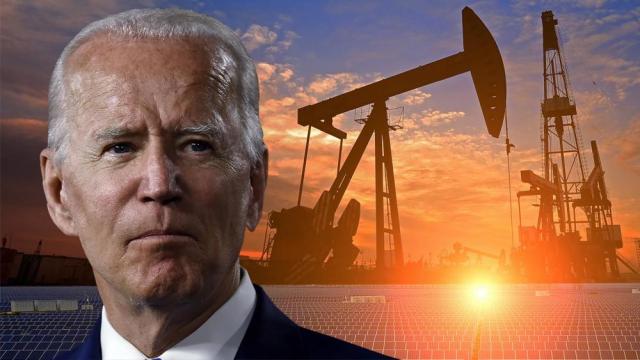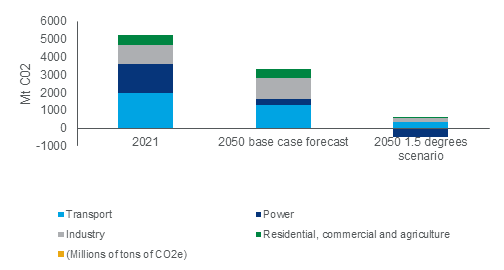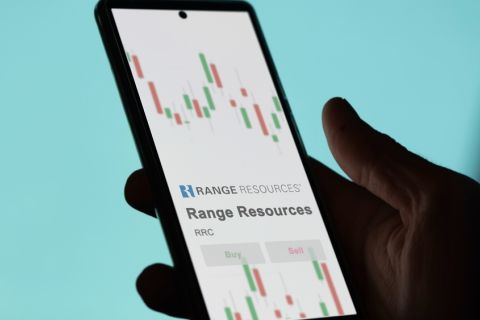
WoodMac researchers noted that in order to reach net-zero emissions, the U.S. needs to quadruple its carbon capture and storage capacity. (Source: HartEnergy.com; vasilis asvestas, pan demin/Shutterstock.com)
At the current pace, weaning the U.S. power sector entirely from fossil fuels by 2035 appears to be an unattainable feat.
Technological limitations, policy design, market structures and even the political and constitutional foundations in the U.S. could hamper the progress of Biden’s net-zero targets, according to a new report by international research consultancy firm Wood Mackenzie.
“Achieving this will take tremendous effort. All sectors of the energy industry will have to be transformed,” noted David Brown, head of Markets and Transitions at Wood Mackenzie.
However, even if net-zero is achieved in a best-case scenario, Brown said fossil fuels will still be a part of the U.S. energy system.
“Even in a net-zero economy, not all hydrocarbons will be removed from the U.S. energy system,” he said. “They will be needed to back up renewables in the power market, for example.”
Additionally, WoodMac researchers noted that in order to reach net-zero emissions, the U.S. would need to quadruple its carbon capture and storage capacity.
“In our net-zero scenario, U.S. needs to reach 1 billion tonnes per annum (tpa) of storage by 2050, up from 25 million tpa today,” Brown said.
He added that priority areas for investment to put the U.S. on a net-zero pathway include a carbon abatement-cost fund to support carbon removal capacity such as CCUS, direct air capture and low-carbon hydrogen.

‘Full of unknowns’
For Biden, achieving net-zero emissions in the power sector by 2035 will be no easy task for a number of reasons.
For starters, current proposals for climate-related spending in the U.S. fall far short of the $10 trillion WoodMac believes will be needed between now and 2050 to achieve Biden administration’s emission goals.
“Based on our understanding of technologies, market policies, the challenges of quickly building transmission lines and the electrification of energy, we believe that 66% clean generation by 2035 is more feasible,” said Brian McIntosh, Wood Mackenzie’s director of North America Power Service.
Additionally, to reach Biden’s net-zero goal, the analysts said wind and solar power—which currently account for about 10% of grid power supply—would have to become the largest generation sources by 2035.
While noting that proposed policies and financial incentives will make renewable technologies relatively inexpensive, McIntosh said solutions that maintain reliability and resilience are both ‘expensive and full of unknowns.’
“A multiday storage solution is needed in a net-zero world but we think we can expect no more than 10- to 15-hour durations from battery storage by 2035,” he said. “The remaining gas-fired power plants will need to be fitted with carbon capture and storage, but the technology’s ability to deal with large-scale carbon emissions in the power sector needs to be proven."
The electric vehicle challenge
Speeding up electric vehicle (EV) adoption will also be vital to achieving net-zero, WoodMac’s report noted.
Last month, President Biden signed an executive order setting a goal that 50% of all new passenger cars and light trucks sold in the U.S. by 2030 need to be zero emissions—a move backed by the country’s biggest automakers.
“Our net-zero scenario for the U.S. transport sector suggests annual EV sales through the end of the decade would need to be around 50% higher than in our base case, which shows a zero-emissions market share of only 27% in 2030,” noted WoodMac’s Head of Road Transport Ram Chandrasekaran.
However, a surge in EV sales could pose a challenge for power markets, the report said, noting that EV buyers would, on average, see a 20% to 30% increase in their household power consumption.
“Should EV sales accelerate beyond our base case,” Chandrasekaran continued, “transmission providers and utilities would need to sharpen their focus on managed charging, reliability and grid resilience to handle the surge in power demand.”
Recommended Reading
Range Resources Expecting Production Increase in 4Q Production Results
2024-02-08 - Range Resources reports settlement gains from 2020 North Louisiana asset sale.
Pemex GoM Oil Platform Blaze Leaves One Dead, 13 Injured
2024-04-08 - A Coter contract worker died from a fire that broke out at Pemex’s Akal-B platform this weekend that also left several others in serious condition, the company said.
TotalEnergies Acquires Eagle Ford Interest, Ups Texas NatGas Production
2024-04-08 - TotalEnergies’ 20% interest in the Eagle Ford’s Dorado Field will increase its natural gas production in Texas by 50 MMcf/d in 2024.
Trillion Energy Begins SASB Revitalization Project
2024-04-15 - Trillion Energy reported 49 m of new gas pay will be perforated in four wells.
TotalEnergies Starts Production at Akpo West Offshore Nigeria
2024-02-07 - Subsea tieback expected to add 14,000 bbl/d of condensate by mid-year, and up to 4 MMcm/d of gas by 2028.





